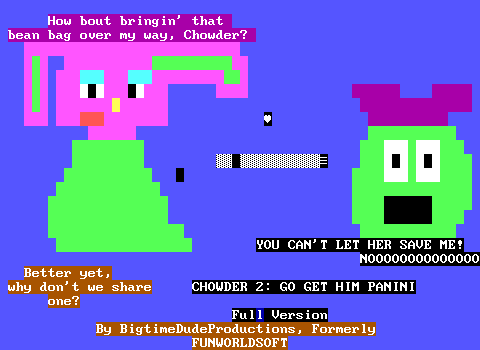If somebody were to ask you to name five prominent ZZTers in 2001, you could save yourself some time and just show them the author list of Death Gate, our poll winner for the month. Death Gate, being an Interactive Fantasies collaborative effort from when the company was roughly at its peak, contains contributions from Hercules, Hydra78, Aetsch, Zenith Nadir, and WiL. All of these names have the distinction of being associated with ZZTers that you can rely on to produce something worthwhile. Take a look at the archived reviews, and things open up with three perfect five out of five ratings. It's difficult to not look at the surface of Death Gate with the expectation that you're going to play something truly amazing.
Whoops. No, it's actually a pretty subpar game. Later review scores are much more middling. But what went wrong here? How do you assemble such a strong team and then do so little with them? Death Gate, as it turns out is a very messy game that feels rushed and incomplete. It's less five authors with one unified vision and more five authors with only the smallest associations with the game's story bumbling around until it's over and done with.
This is Death Gate, and this is what happens when there are too many cooks in the kitchen.
The Origins
Technically speaking, Death Gate is a ZZT world based on the series of fantasy novels The Death Gate Cycle by Margaret Weis and Tracy Hickman. I have only the most basic knowledge of fantasy literature and went into the game 100% unaware of this connection. (Hardly the first time this has happened with me and Interactive Fantasies games. I had no idea about Sierra's adventure games and played the ZZT games based on King's Quest and Quest for Glory thinking them to be completely original adventures.) More specifically, the end credits cite Death Gate, the MS-DOS adventure game from 1994 as the inspiration. Thanks to this information being hidden away at the end, I was again playing a game thinking this was a unique invention. Listen, "Death Gate" absolutely sounds like the name of a cool ZZT game.
The similarities, however, seem pretty light. You play as the same Haplo as you'd find in the non-ZZT game or books on a quest from Lord Xar. The world has been split up into realms by the Sartans to end a war with the Patryns that led to their being banished to a realm known as the Labyrinth. Beyond that though, there's very little that I expect connects with the actual series beyond the intro and first realm. The other contributors to the game may have been just as unaware of the series as I was, instead being free to do their own thing.
Death Gate for ZZT's collaboration isn't co-authorship of a shared world, but rather a series of contributed realms with one per author. There are four realms in total with Hydra78's contribution being the game's introduction chapter, explaining how we have five authors on the game. Historically, collaborations in ZZT have been notoriously difficult to see to completion; the more peoplethat participate, the less likely something will be finished. To some extent, this has changed in recent years with community efforts such as Small Spaces, Town of ZZT Remix, and Phoebus Project. Back then though, a team-built ZZT game was basically telling a bunch of high schoolers to do a voluntary group project with no deadline.
The ending provides a little more information on this as well. The game was conceived as a group project for Interactive Fantasies members in 1998 that received a "lack of realm submissions" and was changed to "the Pazziton Chronicles", which, while it has a great name, also did not really go anywhere. In 1999, Hercules decided to revive the project, and by 2001 the game was finally released "with a lot less realms than intended".
The number of submissions isn't the problem here though. It could have ten realms or two just the same. Other open-submission efforts, like the ZZTV series, succeeded in that each submission could essentially exist in a vacuum. The compilation of user-submitted channels was just a way to get that content into a single package that would be far more likely to be downloaded than a dozen individual ZZT magazines. The issue with Death Gate comes from the requirement that each realm must be a different chapter of the same story, something it fails considerably at.
The Lore

A lot of what sets the game up for failure is in the opening introduction credited to Hydra, where the game is the closest to its literary source material that things will ever be. Death Gate begins with what is a very solid opening cut-scene. A group of Sartans that realize the Patryn are winning the war have decided on taking the extreme measure of dividing the Earth into five realms by a process known as the Sundering. It's a great start that immediately introduces the player to the villains, quickly sets up the conflict between the Sartans and Patryns, and gives explanation for this whole "realm" thing that will be so important.
Jump ahead 2000 years and the Patryns have all been banished to the fifth realm, the Labyrinth which sucks shit. The goal has always been for your people to escape from the Labyrinth and now the finish line is in sight! A powerful sorcerer known as Lord Xar has broken through the final gate, providing an exit and a chance for the Patryns to travel to the other realms. Here we are introduced to the protagonist "Haplo" who meets up with Xar at the final gate and is told to follow him.
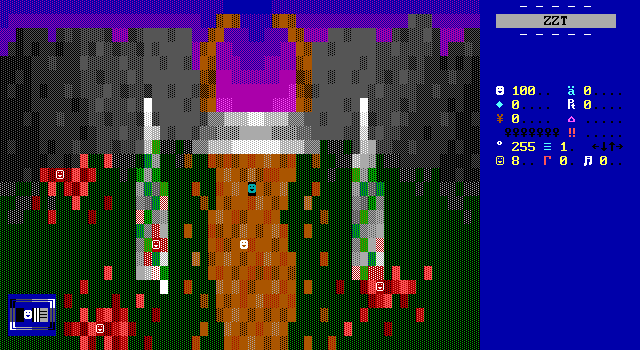
It's all straightforward fantasy and I've got zero complaints! Some magical architecture has been drawn to provide you with something neat to look at. The final gate has bloody corpses scattered around the area, and the board looks like an oppressive and evil place! Hydra does a great job establishing this realm with just a single board.

...and then Xar vanishes and the scene shifts to a modern potentially non-fantasy home. It's difficult to say for sure what you're looking at here at first. There's a toilet and tub in the bathroom. Then there's some weird caged bomb-looking thing in a bedroom? Another room has what I assumed to be a person reading a book and what I kept parsing as a computer on the right side of the large desk, but couldn't say for sure.
Oh. This is Hercules's home. The ZZTer and one of the authors on this game? His presence marks a rapid shift in the expectations of what kind of game Death Gate is going to be. A faint idea that this may be a fish out of water story where Hercules is going to be the savior of the realms or whatever and taken from his home to save the day is extinguished with the second line of text. Hercules is well aware there are other realms, but apparently not too informed as he's unsure if people exist in them.
With perfect timing, Lord Xar manifests in the hallway and just styles on Hercules with his knowledge. Here the player learns of the actual goal of the game: By reuniting the members of the ancient council in each realm it should be possible to unite the realms once more. Xar quickly leaves a confused Hercules behind with little more than to expect a visit from Haplo.
Sorry, why is Hercules the ZZTer being told this? There's good reason it turns out.
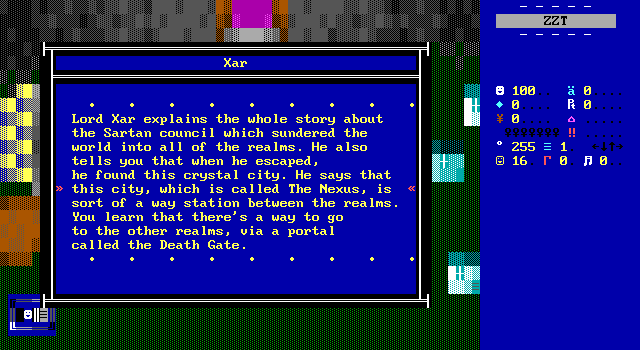
The player is taken back to the edge of the Labyrinth while dutiful Haplo is still waiting for Xar to return. Xar repeats what he just told Hercules, which makes the whole scene's existence even more strange before taking Haplo to The Nexus, the game's theoretical hub from where any of the other realms can be reached.
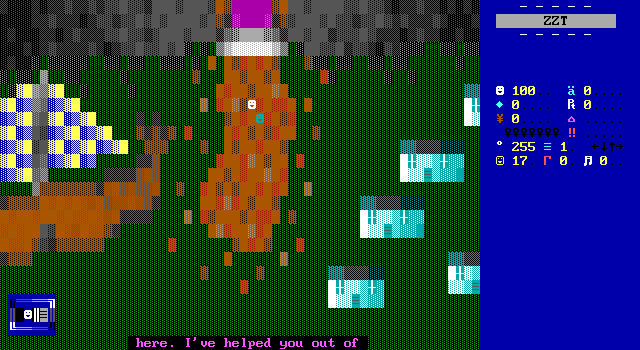
I say theoretical because the player will never get to explore the crystal city or anything else in the Nexus. Instead, you'll be on the dragon ship and sail it through the Death Gate to travel from realm to realm as needed.
Because there hasn't been enough lore dumped into your lap yet, Xar gives Haplo the opportunity to ask some questions.
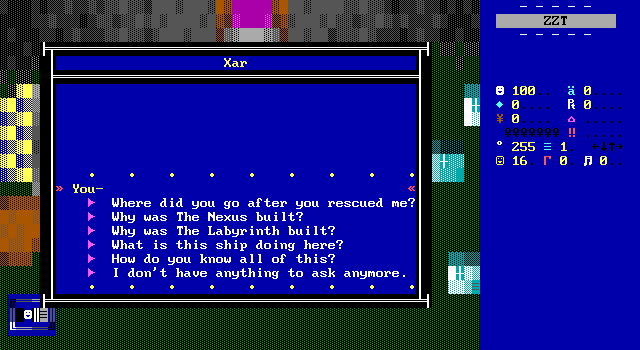
Most of the information contained here has already been shared with the player, so I suppose Hydra must have felt like really hammering this information in. Xar went to Hercules's home. The Nexus was built as a way station between the realms. The Labyrinth was built by the Sartans to destroy the Patryns. The ship can sail to other realms via the Death Gate. The only question that's really of interest is how Xar knows all of this.
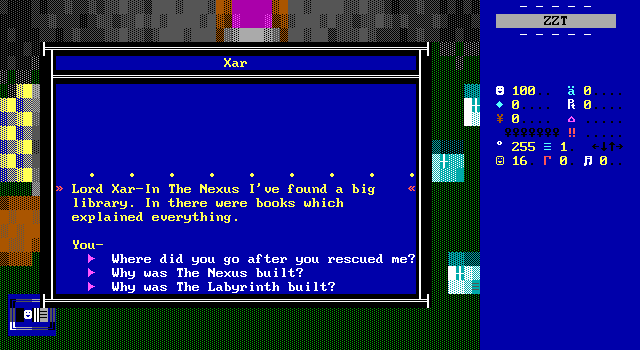
It sounds so unimpressive when it's phrased like this rather than "I have spent my years studying the ancient texts" or something. Dude just stumbled into the right building with the right books. I'm calling this "Deus Ex Biblioteca" from now on.
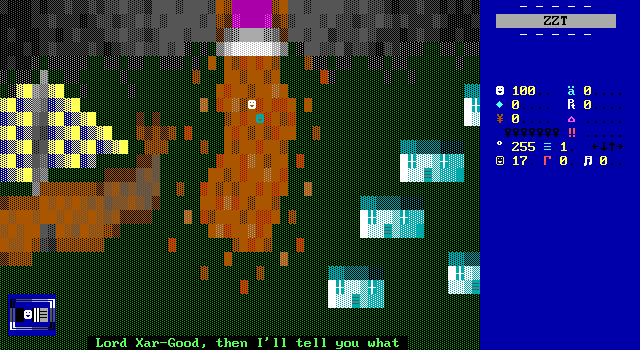
Once your questions have been answered Xar gives Haplo the same information he gave Hercules about the council. This all feels incredibly redundant doubling up like this. Having Xar visit Hercules honestly makes things more confusing as Xar seems to be able to travel between realms without the dragon ship and also seems to have no interest in assembling the council himself, delegating all the work to Haplo. Reading summaries on Wikipedia this seems to make a little more sense there where Xar has other things going on. In this ZZT game though, there's nothing more to Lord Xar than wanting to reunite the realms and have everybody live in peace, which makes it odd for them to not either travel together or even simply have Xar go off getting some council members in these realms while Haplo gets the council members in those realms.
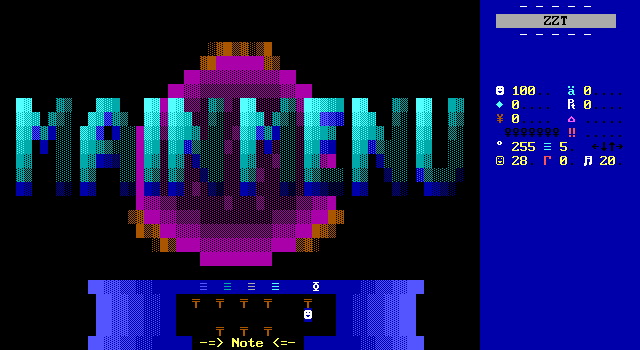
The introduction sequence is over and Haplo is transported to the game's main menu. This is kind of an unusual way to go about things putting the menu in the middle here. It's got the usual Interactive Fantasies information and game credits included. It's also where you can choose which of the four realms to travel to next, or the Vortex when all the council members have been brought together. The combination of in-universe realm menu with the standard pre-gameplay ZZT menu is outright bizarre to me. I've never seen a double-duty board in this manner before. From a practical standpoint, it makes some sense, but from a gameplay standpoint, it's very much taking you out of the world the game wants to build. The giant lettering certainly isn't helping either. I think the purple thing behind is meant to be the Death Gate portal Haplo is sailing through.
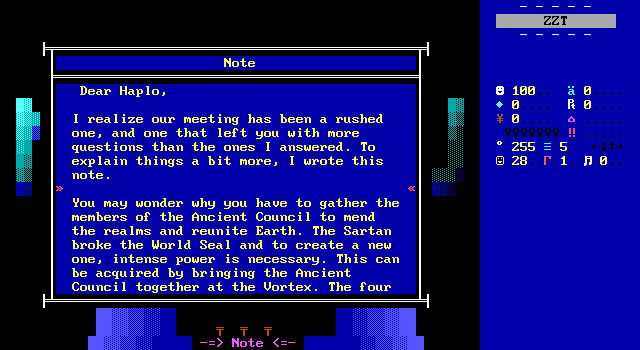
Oh yeah, and of course Xar left us a note with one final lore dump to explain this Vortex thing and how there's a Spirit Link between them which will enable them to perform the Reformation. Of course, the original council existed 2000 years ago so your actual targets aren't powerful sorcerers or anything, just reincarnations with the same souls who will have the same bonds when brought together.
The four members of the Ancient Council
are Hercules, WiL, Zenith and Jacob
Hammond. Hercules was the one who
originally formed the Ancient Council and
thus I ask of you that you visit him
first. I have already told him about
your coming, though he has no idea what
is about to happen.
Haplo, I ask this of you. Bring me the
four members of the Ancient Council and
you will not be forgotten. Not by me, nor
by Patryn history books. This, however,
is not about honor. It's about the
existence of our own race.
May luck be on your path and may this
information be sufficient.
Signed,
Lord Xar
• • • • • • • • •
It's also where the game finally explains itself. You see, Hercules is one of those reincarnations. The other authors of the game are the other reincarnations making Death Gate actually a game about finding ZZTers and convincing them to help out. This is just such a baffling decision to me. In the novels there is no council, with Haplo's target in each realm being a "seal stone". This could have just as easily been the case here, but the strange ties to the ZZTers the game insists upon mean that this game is going to feature ZZTers writing themselves while simultaneously needing to fit into a fantasy setting.
It's gonna get weird.
Hercules's Realm
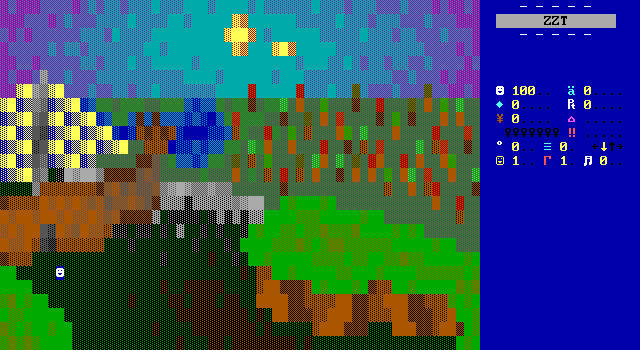
Not immediately though. Hercules opens up with this gorgeous looking board that does a great job of communicating depth to the space. Haplo safely lands in this first realm out the outskirts of a forest. This is the sort of board that would serve well as promotional art for the game: a purple and cyan sky lit by multiple celestial bodies, this ship very much out of water, a wooded area off in the distance, and it's all nicely delineated between walkable foreground and distant background. This is a great hook even knowing we're here to track down a ZZTer on not-Earth, and it definitely gives me hope that this game will have something going for it.
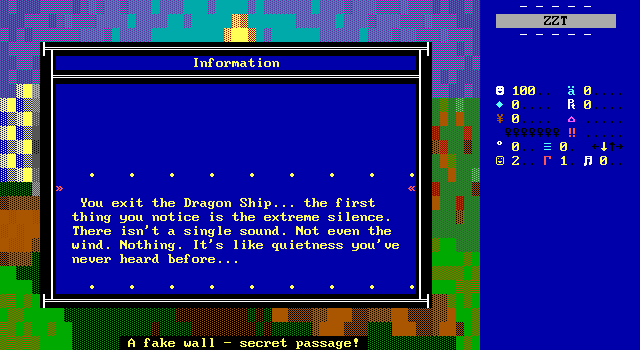
It's built up even more through an immediate popup as well. Most ZZT boards are expected to be silent, so by drawing attention to it here Hercules is able to make the norm seem a bit more unusual. It also builds up the location as a fantastic place and not just a pretty one. There's a missed opportunity here to throw in a silencer object and mute the player's footsteps as well. Instead Haplo gets to break the silence as he follows the path into the woods.
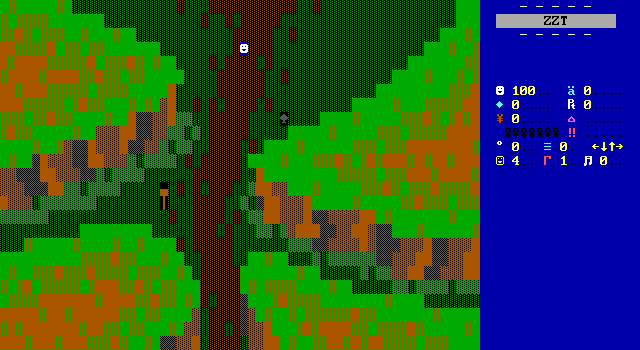
Woods are just kind of a staple of Herc and Hydra. The odds of venturing through one are incredibly high in any of their games so this is hardly a surprise to see a board like these. This one takes on an ultra-dense look with not a single break in the trees that guide the player through the board. Other games would tone it down a bit more than this as maximum density can also kind of be read as if you're surrounded not by trees but by cliffs with grassland running across the top.
Trying not to be too distracted with not being able to see the woods for the trees, Haplo gets to meet his first resident of this realm, a dwarf with the incredible name of "Ratgar Mohash". Ratgar tries to be intimidating, polishing his axe and warning Haplo that Hercules won't like it if he's here to cause trouble, but Haplo doesn't flinch and just keeps asking questions about where to find Hercules. Ratgar says that it might be wise to visit with Ernest who lives nearby first and provides a password in order to be able to speak with him.
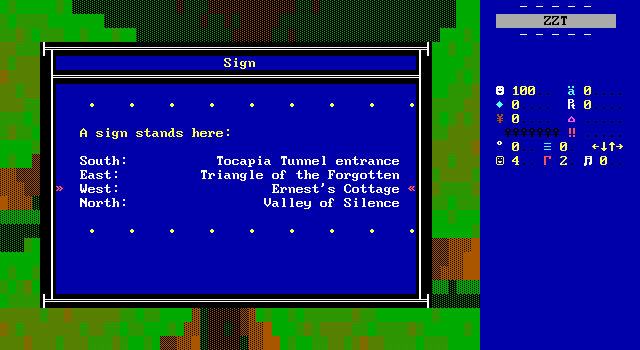
The sign clears up where to go and also explains the silence mentioned on the previous board. It's a bit of a shame that nothing is done with the concept of the silent valley at all. Just a simple "It's quiet here." and immediately leaving.
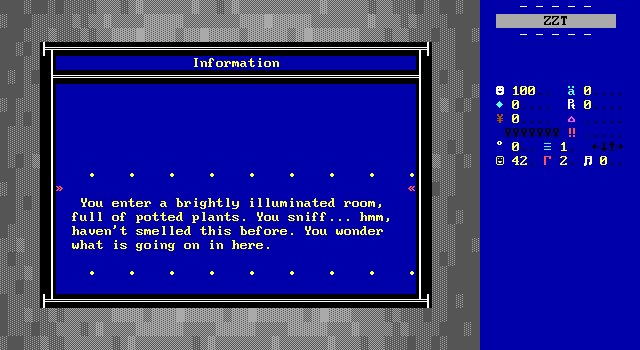
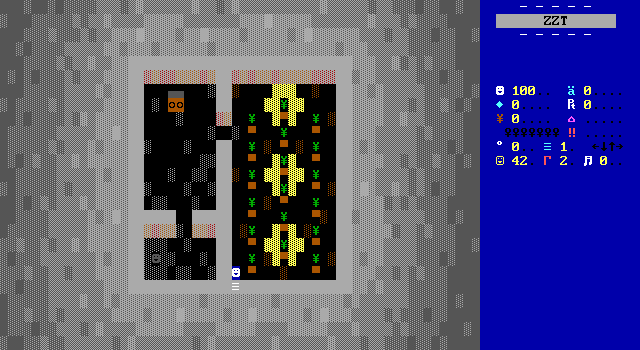
Ernest's cottage is a grow-op. Not a joke. If you touch any of these funny smelling plants, you'll get a "cannabis sativa" message on the bottom of the screen. Again though, as with the valley of silence, this is irrelevant to anything. Haplo remains straight edge for this adventure.
The only thing to actual do here is speak with Ernest who won't say anything until Haplo says the password. Afterwards, he hands him a shiny round object and begins to ignore him. So far, Hercules is very guilty of offering up puzzle solutions before the player even knows the puzzle exists. You're certainly going to talk to Ratgar before you know you need a password to speak with Ernest, and now Ernest is giving us an item to use in a location Haplo still hasn't visited. This is normally just a bit of not thinking the design of a puzzle through enough, but with how short these will actually be, this is actually really robbing you the player of the chance to feel like your actions are what makes Haplo succeed in his quest.

At least Ernest doesn't say what the orb is for so the player gets to decide if they want to visit the "Triangle of the Forgotten" or head to "Tocapia Tunnel". When I proofread this article, I'm going to have to make sure I don't constantly write "Tapioca" instead, which is 100% how I have read the tunnel's name every time I've seen it.
There's plenty of comparisons to make between Hercules's realm and the opening area in Deceiving Guidance which would have been released earlier that same year. That game credits the graphics to both Hercules and Hydra, so I'm assuming it's Hydra who made the incredible Sacrifice circle board that runs circles around Herc's triangle.
Shortly after playing this game, I had to look up the release date, as I just assumed Deceiving Guidance would have come after and was really surprised to see it's the other way around. Hercules's realm here looks a lot less detailed. Not at all to the point where it's bad, but enough where it seems like an odd shift in graphical prowess on display. Although, the game's end credits discussing the game's development do make it clear that this game was started some time ago, so perhaps this is just some older work by Hercules.
Anyway, when Haplo stands on the obvious marked spot in the center of the triangle, a spirit will appear and ask why they were summoned, to which Haplo has no real answer because he didn't actually know anything was going to happen here. It's for the best though as this spirit happens to have "The Key of Knowledge", another solution to a puzzle yet to be revealed. In order to be given the key, Haplo must answer some questions.
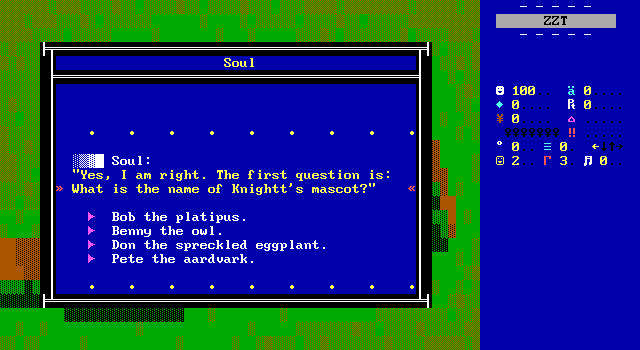
Ah, just a sinking feeling in my stomach as I get greeted with ZZT community trivia. First off, this just kills the pace of the game for anybody who wasn't around back then, and probably for plenty who were. Incorrect answers are punished by the entire sequence starting over, so there's no actual danger, just a whole bunch of brute-forcing if you need to. Of course, there's also the weird break in tone. I'm in the "Triangle of the Forgotten" and being asked about "Benny the owl", a name I have never heard despite years of being in Knightt's IRC channel #loungeact. Owls, yes. Benny, no.
Here are the answers to the questions. which I wound up cracking open the game's code for on the third one:
- Benny The Owl
- Dr Dre and Ice Cube
- rat
- Andrew
- craNKGod
Strangely enough, the fourth question asks who doesn't live in this realm taking a departure from ZZT trivia to something any player could actually answer. Trivia is not exactly a fun game mechanic, so while it might be more thematically appropriate to ask questions about things in Death Gate, I can't say I'd enjoy it all that much more than discussing who is or is not a part of Eaglerock Interactive.
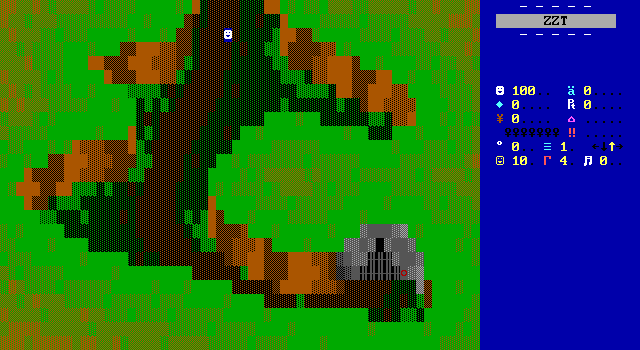
Orb and key in Haplo's possession, it's time to brave top... topacia? tunnel. Tocapia. That's it.
Before the gate will even open, Haplo must place the orb on the orb holder.
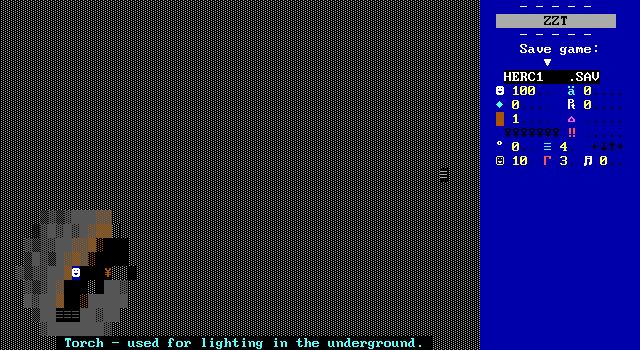
Ooh? Is it Underdark time? I was excited for this! Hercules and Hydra are both credited for making the dungeon levels in Deceiving Guidance so I had complete confidence in Hercules here. A little bit of crawling around in creepy dark places is just what this game needed to turn things around.
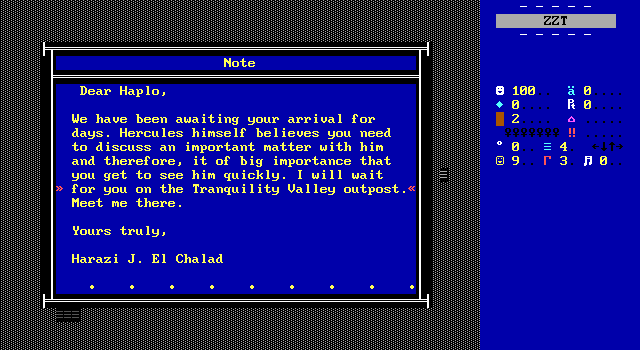
This one begins with a note on the wall for Haplo from Harazi, another new character with little time actually seen in game. It gives Haplo a goal beyond just finding Hercules and the direct connection established between Harazi and Hercules means that it's more sensible to find this person than Ernest.
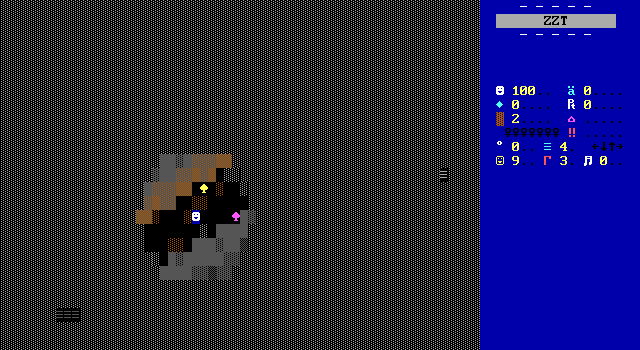
The path from the entrance to this point is entirely linear. These spade objects aren't moving, but perhaps they haven't been aggroed yet.
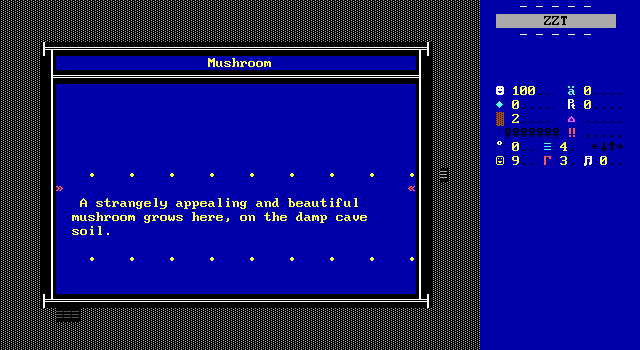
Oh. I mean, they do look nice.
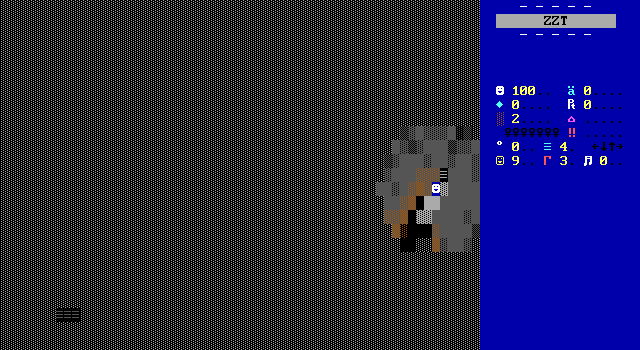
And that's it. No dungeon crawling. You walk through a single dark board, read a note, check out some cool mushrooms. I feel betrayed.
Okay, admittedly this game doesn't bill itself as a dungeon crawler or anything. It just hasn't really wowed me at all yet except for having some nice visuals. So far, this game is just going on a nice walk, which can be great, but it's not what I would have expected from an IF release of this vintage and setting.
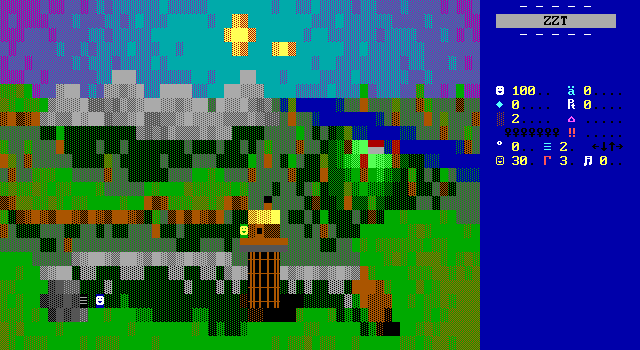
Okay, also admittedly this game does have some great scenery even if that's not what I'm after here. Up on this mountain there's a fun looking watchtower overlooking the valley below. I was hoping this would be an instance where you could compare this location to the view from the Valley of Silence earlier and get an idea of just how far Haplo traveled. While this isn't the case, Hercules did put in that effort into making the world fit together. If you compare the view here not to the valley, but to the scene where Xar visited Hercules, you can recognize the red trees and the house along the river as Herc's.
The man in the watchtower is none other than Harazi J. El Chalad who while friendly, won't hold a conversation without Haplo tossing him the Key of Knowledge. Without it, you're stuck turning back around and getting it from the Triangle. It's unstated what the key is actually used for. Harazi doesn't unlock anything with it or give any indication as to what its actual purpose may be. Instead, he just explains that Hercules is currently on Mount Olympus.
That tracks.
The easiest and fastest way to get there is to just head to the nearby clearing where Harazi keeps his hot air balloon and go float on over.
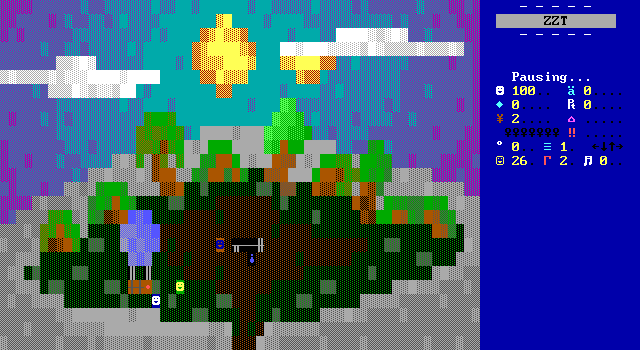
Love that little balloon. The player is taken immediately to the peak where Hercules is relaxing with a bottle of "fresh, sparkling water". Not gonna lie, I was expecting booze here.
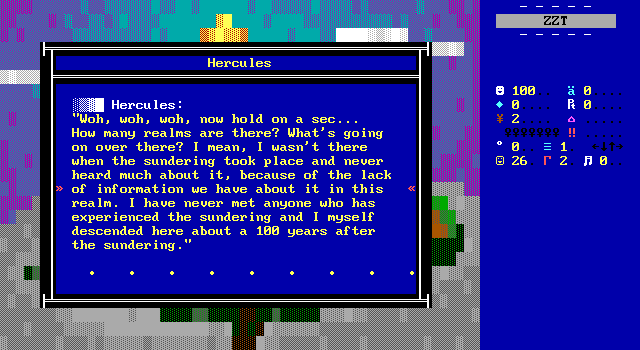
Haplo and Hercules finally meet and the conversation goes smoothly, though Hercules doesn't quite understand what's going on due to his ignorance about the other realms beyond that such places exist. We get a recap of the story so far (again), with Hercules commenting on how the Sartans are trying to take over this realm, but he's in charge of this region and has managed to keep them at bay to the point where they don't come out this way any longer.
There's almost something really interesting philosophically here, and it's such a shame that it will go entirely unexplored. As mentioned before, the source material for Death Gate doesn't have a council, just some stones. By making them people, there's potential to explore some interesting themes where the council-members being sought are the "same" people as those who ruined the world with the Sundering in the first place. I'd love to see how Hercules and the other characters could potentially react to the news that this is in a way their fault. They have no real familiarity of the war's origins and are righting a wrong that they have no memories of causing. The persuasive process to get somebody to go along could be a really original concept, having to get these people to acknowledge that they're part of the council and did what they did; and what it means that, for 2000 years their actions have isolated parts of the world from each other. It could be some heavy stuff full of guilt and whether or not that guilt is misplaced. You could have somebody stand by their decision, not wanting to admit that it was the wrong thing to do when Haplo shows up and says "Hey war criminal, make it right".
Alas, none of the authors will give us anything of the sort, and while some council-members will be a tougher sell on coming along with Haplo, their reservations won't have anything to do with their past lives.
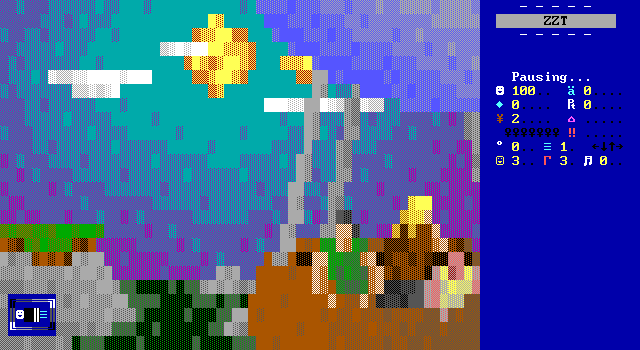
I take it all back, whatever issues this game has, it has a lovely art board of the crew flying off in a hot air balloon. This is easily the most distinct scene in the game and is such a great way for this chapter of the game to draw to a close.
Hercules wonders if he'll ever be able to return to this place and what will happen when the realms are actually reunited. Haplo can't answer these, saying that Xar would know better than he would. Then there's still yet one more recap of the whole Spirit Link thing and the grand plan of how to unify the realms once more. I get the idea that Xar probably was meant to have some more sinister plans as in the source material.
The Verdict
This is a pretty decent start really. The scenery really carries things forward offering the player something to keep them interested in moving forward. Since this chapter is required to be the first, it serves the role of a gentle introduction to what Death Gate has to offer. From that perspective the lack of enemies in the tunnel and forests as well as Hercules being completely on board with Xar's plan makes it a nice opener. Playing the game to this point, there are some minor grievances with how often we're hearing the same story and plans without getting any new information on them, and the ZZT trivia is a definite miss, but while I wasn't in love with Death Gate here, I had no reason to doubt it would be a fun adventure as things got moving in the other realms.
Aetsch's Realm
Again, it's worth noting beforehand that once you complete Hercules's Realm, Haplo is free to travel to the other realms in any order you choose. In other ZZT games with non-linear components like The Secret of Cannibal Island or The Mercenary this can make a considerable impact on the experience. In those games, both items as well as resources like health and ammo can change dramatically based on the order the player happens to do things. The downside of this remains that (in a well-designed game) every area has to be roughly the same difficulty as any can be the player's first or last obstacle to overcome.
In Death Gate, there will be no such issue. Resources do still get carried over, and in my playthrough this means having a few spare torches, but every realm is so isolated from the rest of the game that it won't matter at all. The non-linearity here is nothing more than an afterthought to how the menu should arrange things. Nothing changes based on the order you go to each realm which makes it seem pointless to deviate from the order the menu presents things. The only change to be felt by the player is the ups and downs of their own feelings on the game depending on what order they wind up going with.
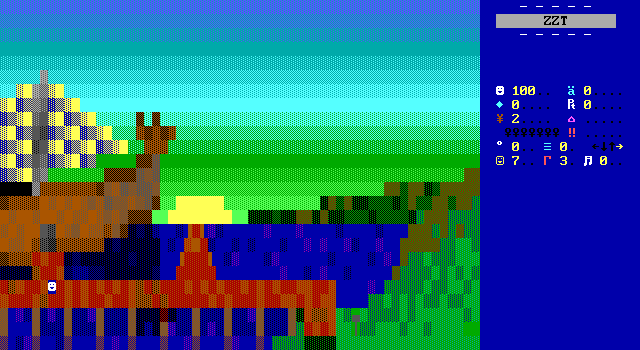
Our second realm is brought to us by the letter Aetsch, who of the numerous authors of Death Gate is the one I have the least familiarity with. Again though, a promising start this time with the dragon ship docked in a body of water. The sun is setting, and I am unsure if this is meant to be an otherworldly place with a green tint to the sky, or if it's Aetsch misunderstanding the stock horizon blend seen in numerous toolkits and placing the sun on the ground.
During my playthrough, the idea of a misplaced sun didn't occur to me, so I just thought it was a cool sky. A few years later, lots of Aetsch's art would be compiled into Ownage Triangle, named for three ZZTer artists (Aetsch, Kracken, and Nadir who has his own realm in this game) constantly trying to one-up one another. I'm dwelling too much on this sun here, but remain unsure if it's a deliberate aesthetic or not. I'm on team green sky because it rules.
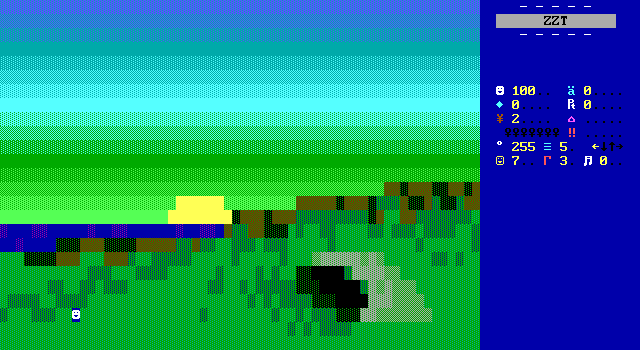
Leaving the dock and heading to the mainland reveals more green sky sun so I'm leaning emerald skies here. The grass has a blue tint which I think is a really simple and effective way to make it apparent that you're somewhere other than where you started. Quest for the Immortals does this as well with your country having dark green grass compared to the bright greens of the enemy in Bermuda.
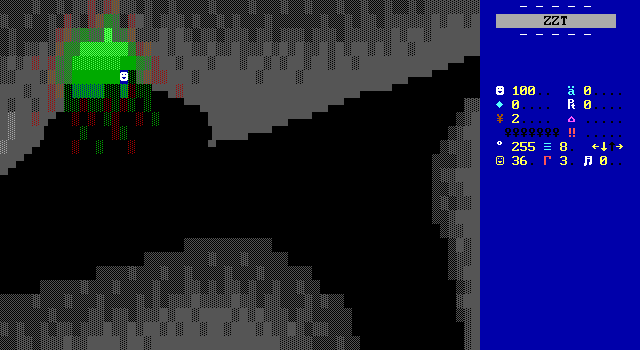
The only way forward is by venturing into a cave. This interior shot is also pretty nice. Aetsch is making some more natural and graceful looking curve here with half block objects that make the cave feel less jagged. The path splits in three, but it won't take long at all to get through each path.
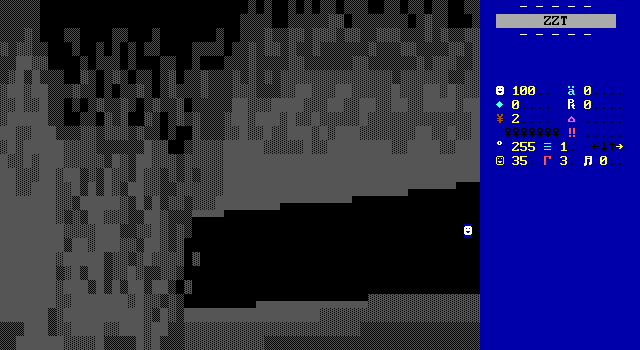
A cave-in blocks passage west.
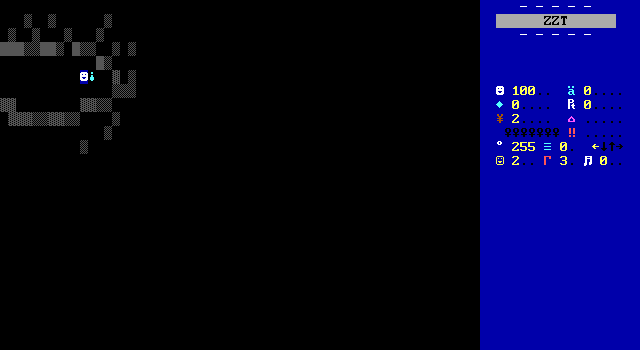
The tunnel ends immediately to the east, though a message appears to explain that you walked down this path uneventfully to reach this point. The upside-down exclamation point is an exciting character to see in ZZT. It could be a sparkling water, a magic potion, or your choice of alcohol. Here, it's... a jar of sauerkraut?
This is a second author joining in on the solutions before puzzles bandwagon. At least this one is more fun to imagine what the heck it might be needed for.
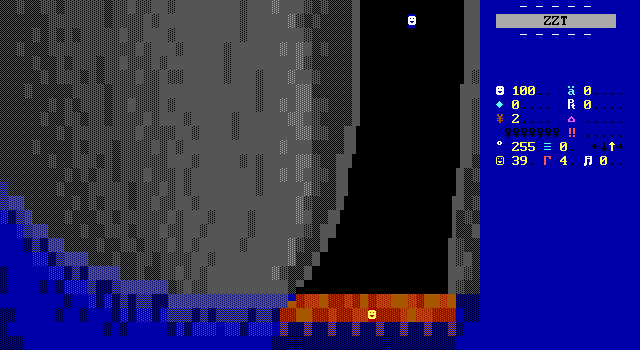
The southern path still does some nice work with the cave opening up to the sea. I don't know if this is a pirate's cove situation or what. There's a person though, which gives Haplo something to do at least. Speaking with him reveals that the old man has lost his memory, but he'll give Haplo "something cool" in exchange for some sauerkraut.
Old man: Oh joy!
Old man: **snort** Ogh monint.
Old man: Okay. Here you are, my boy.
• • • • • • • • •
I see! Aetsch is definitely running a more absurd realm than that of Hercules which seemed to be sticking to a pretty standard fantasy setting. This wouldn't be an issue under most circumstances, but this realm is definitely breaking away from the tone of the game established in its introduction and first realm. It really makes me curious what the rules were for creating a realm for the game in the first place.
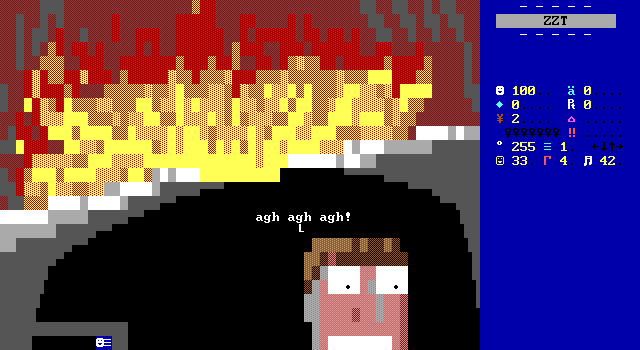
The explosives can be set by the collapsed section of the tunnel and used to blast open a way to progress. Aetsch does this goofy little art board as a transition between pre- and post-explosion.
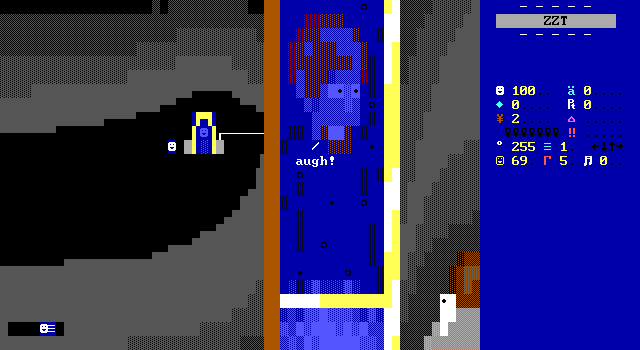
Which leads to this combination cut-scene and art board where Haplo finds a man trapped in some sort of tank. There's not a whole lot to this cave, but it's certainly given me some Winter vibes.
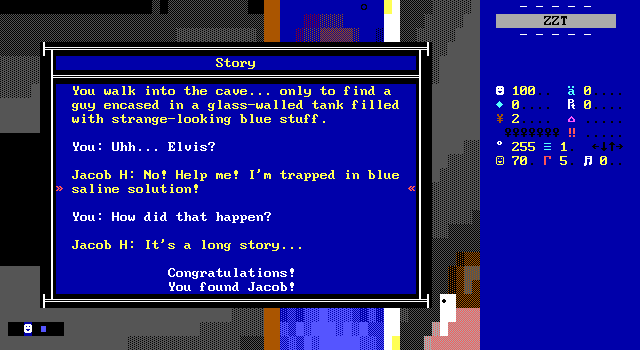
Oh. It's Aetsch.
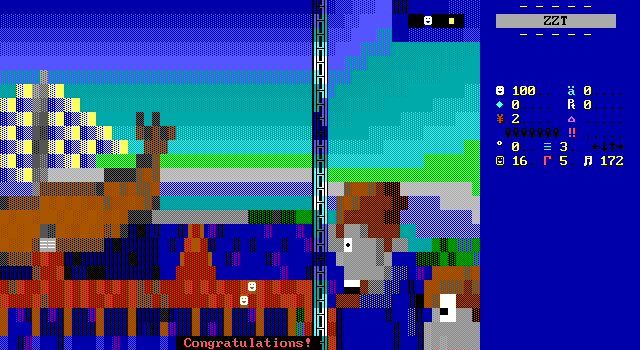
Cut to the surface where the two head to the ship together. Poor Jacob looks like he's just a head in a jar in his first picture with that blue outfit on.
The Verdict
Hey. That was basically nothing. Like Hercules's realm, Aetsch's consists of just following the path and grabbing an item or two before it's needed. With Hercules's realm, that didn't feel too bad with the sense that this was just the beginning. Here, it's just disappointing. Like the first chapter, the art is definitely the strongest aspect. Aetsch however, throws the game's story out the window entirely. Haplo doesn't even explain the whole Death Gate and Spirit Link stuff to Aetsch. He just busts him out of a tube and shoves him onboard his ship.
This one really makes me wonder how Aetsch got onboard for this. There's so little to this realm that it just feels incredibly incomplete, like the sort of thing submitted to the game more out of obligation than anything else. Maybe the game was being held up waiting for Aetsch to send something in and he felt like he had to? I'm really unsure what the deal is here, but this feels a lot like a 24 Hours of ZZT contest entry where the participant suddenly realized they had an obligation that day and would only have like a third of the contest at most to work. Death Gate is rapidly falling apart here, unfortunately.

